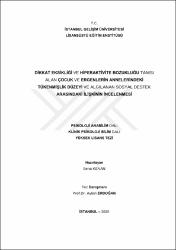Dikkat eksikliği ve hiperaktivite bozukluğu tanısı alan çocuk ve ergenlerin annelerindeki tükenmişlik düzeyi ve algılanan sosyal destek arasındaki ilişkinin incelenmesi
Abstract
Dikkat eksikliği ve Hiperaktivite Bozukluğu (DEHB), özellikle çocuk ve ergenlerin aile, okul ve sosyal yaşantısını zorlaştırmaktadır. Bozukluğun getirisi olarak bireylerde dürtüsellik ve hiperaktiviteye bağlı davranış problemleri ortaya çıkmaktadır. Bu yüzden birçok ebeveynin DEHB ve davranış sorunları olan bir çocukla yaşaması ve onu kontrol edebilmesi zordur. DEHB ebeveynler ve özellikle anneler için önemli strese neden olabilir. Bu nedenle annelerin toplumdan daha da kapsamlı sosyal desteğe ihtiyacı vardır. Çünkü DEHB tanısı alan çocuklu annelerin diğer annelerden daha az toleranslı olmaları ve daha kolay tükenmeleri muhtemeldir. Amaç: DEHB tanısı alan ve almayan çocuk ve ergenlerin annelerindeki tükenmişlik düzeyi ve algılanan sosyal destek düzeyinin kıyaslanması ve tükenmişlik düzeyi ve algılanan sosyal destek arasındaki ilişkinin incelenmesi amaçlanmıştır. Yöntem: Bu araştırma İstanbul ilinde bir özel hastanenin çocuk ve ergen psikiyatri polikliniğine başvurmuş, DEHB tanısı alan çocuk ve ergenlerin annelerindeki tükenmişlik düzeyi ve algılanan sosyal desteğin düzeyi ve tükenmişlik düzeyi ve algılanan sosyal destek arasındaki ilişkiyi incelemek ve onlardaki bulgular ile DEHB tanısı almayan çocuk ve ergenlerin annelerindeki tükenmişlik düzeyi ve algılanan sosyal destek düzeyini kıyaslamayı amaçlayan ilişkisel tarama türünde bir çalışmadır. Çalışmaya 7-12 yaş grubu arasındaki, psikiyatri desteği alan gönüllü DEHB tanısı alan ve almayan 120 DEHB'li çocuk ve ergenin anneleri dahil edilmiştir. Kontrol grubu karışık, genel toplum örgütlerinden seçilmiş ve herhangi bir psikiyatrik ve tıbbi hastalığı olmayan çalışma 100 anne katılımcı olarak çalışmaya dahil edilmiştir. Araştırma verilerine, Sosyodemografik Veri Formu, Maslach Tükenmişlik Ölçeği (MTÖ) ve Çok Boyutlu Algılanan Sosyal Destek Ölçeği (ÇBASDÖ) kullanılarak ulaşılmıştır. Verilerin analizi yapılmış, sayısal olarak bilgisayara girilmiş ve SPSS (Statistical Package for Social Sciences-SPSS 25.0) ile istatistiksel analiz sonuçları çıkarılmıştır. Bulgular: Bu çalışmada, DEHB tanısı alan çocuk ve ergenlerin annelerinin Duygusal Tükenmişlik Alt Boyutundan almış oldukları puan DEHB tanısı almayan çocuk ve ergenlerin annelerinden yüksek olduğu için (istatistiksel açıdan p<0.01) anlamlı farklılık bulunmuştur. DEHB tanısı almayan çocuk ve ergenlerin annelerinin Kişisel Başarı Alt Boyutundan almış oldukları puanın, DEHB tanısı alan çocuk ve ergenlerin annelerinden daha fazla olduğundan (istatistiksel açıdan p<0.01) anlamlı bir farklılık saptanmıştır. Kişisel Başarı olumlu bir alt boyuttur. Duygusal Tükenmişlik Alt Boyutu ile Çok Boyutlu Algılanan Sosyal Destek Ölçeği puanı arasında zayıf seviyede ve negatif yönlü ilişki görülmektedir. DEHB tanısı alan çocuk ve ergenlerin annelerinin tükenmişliği arttıkça algılanan sosyal destekleri azalmaktadır. Sonuç: Annelerin eğitim durumlarına, çalışma durumlarına, çocuk sayılarına, aile yapılarına, aylık gelir düzeylerine göre tükenmişlik ölçeği puanları ile algılanan sosyal destek ölçeği puanları farklılaşmaktadır. Araştırma sonuçlarına göre algılanan sosyal destek düzeyi ve tükenmişlik arasında istatistiksel olarak negatif yönlü bir ilişki olduğu gözlenmiştir. Tükenmişlik düzeyinin yüksek olması kişiler arası ve ailesel ilişkilerde sorunlara yol açabilmekte, kişinin verimliliğini azaltıp psikosomatik rahatsızlıklara da yol açabilmektedir. Bu nedenle üzerinde çalışılması ve önleyici faktörleri saptayıp gereken tedbirlerin alınması çok önemlidir. Attention Deficit and Hyperactivity Disorder (ADHD) complicates the family and school life of children and adolescents. As a result of the disorder, behavioral problems related to impulsivity and hyperactivity arise in individuals. Therefore, it is difficult for many parents to live and control a child with ADHD and behavioral problems. ADHD can cause significant stress, especially for mothers. Therefore, mothers need more comprehensive social support than society. It is possible that mothers if children diagnosed with ADHD are less tolerant than other mothers and are more easily depleted. Aim: To compare the burnout level and perceived social support relationship of mothers and adolescents with and without ADHD and to determine the burnout level and perceived social support relationships. Method: This study investigated the relationship between burnout level and perceived social support and burnout level and perceived social support in mothers of children and adolescents diagnosed with ADHD, who applied to a child and adolescent psychiatry outpatient clinic of a private hospital in Istanbul, and burnout in children and adolescents who were not diagnosed with ADHD is a study of relational screening that aims to compare the level and perceived social support level. The study included 120 ADHD children, adolescents and their mothers between the ages of 7 and 12 and their mothers, who received psychiatric support, and who could not be diagnosed with ADHD. The control group was selected from mixed general public organizations or without any psychiatric and medical diseases. Research data were accessed using the Sociodemographic Data Form, Maslach Burnout Inventory (MBI) and the Multidimensional Perceived Social Support Scale (MSPSS). While analyzing the obtained data, the data were entered into the computer as a numerical expression and statistical analyzes were done using SPSS (Statistical Package for Social Sciences-SPSS 25.0). Results: In this study, a statistically significant difference was found at the level of p<0.01 since the scores of the mothers of children and adolescents diagnosed with ADHD from the Emotional Exhaustion subscale scored more than the mothers of children and adolescents who were not diagnosed with ADHD. A statistically significant difference was found at the level of p<0.01 since the scores of the mothers of children and adolescents who were not diagnosed with ADHD. Personal Accomplishment subscale were higher than the mothers of children and adolescents diagnosed with ADHD. Personal Accomplishment is a positive subscale. A weak and negative correlation was found between the Emotional Burnout Subscale total score and the Multidimensional Perceived Social Support Scale score. As the burnout of the mothers of children and adolescents diagnosed with ADHD increases their perceived social support decreases. Conclusion: Burnout scale scores and perceived social support scale scores differ according to the mothers' educational status, employment status, number of children, family structures, monthly income levels. According to research results, a statistically negative relationship was observed between perceived social support level and burnout. The high level of burnout can cause problems in interpersonal and family relations, decrease the productivity of the person and cause psychosomatic disorders. For this reason, it is very important to study and identify preventive factors and take precautions.
Collections
- Yüksek Lisans Tezleri [1219]
The following license files are associated with this item:


















